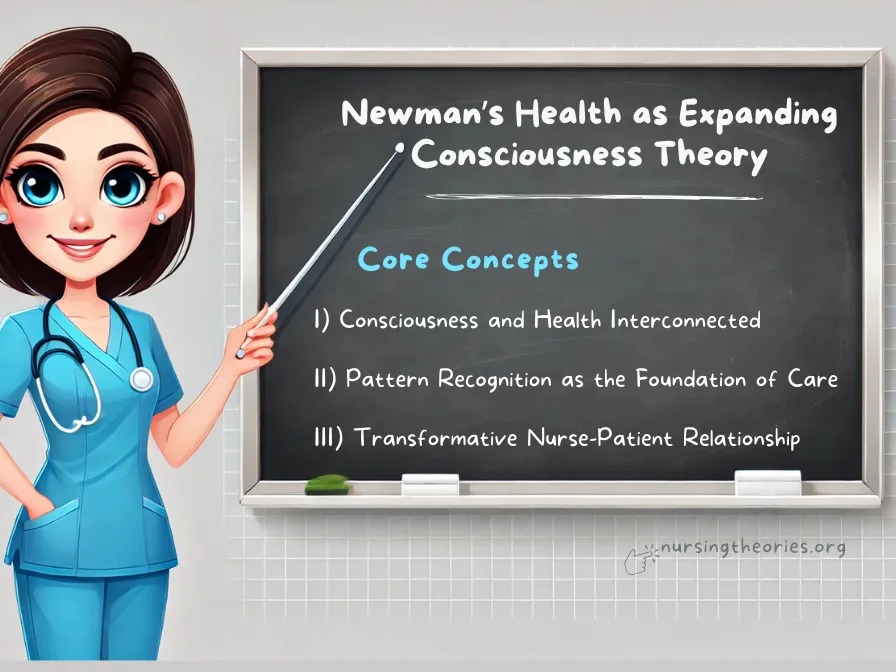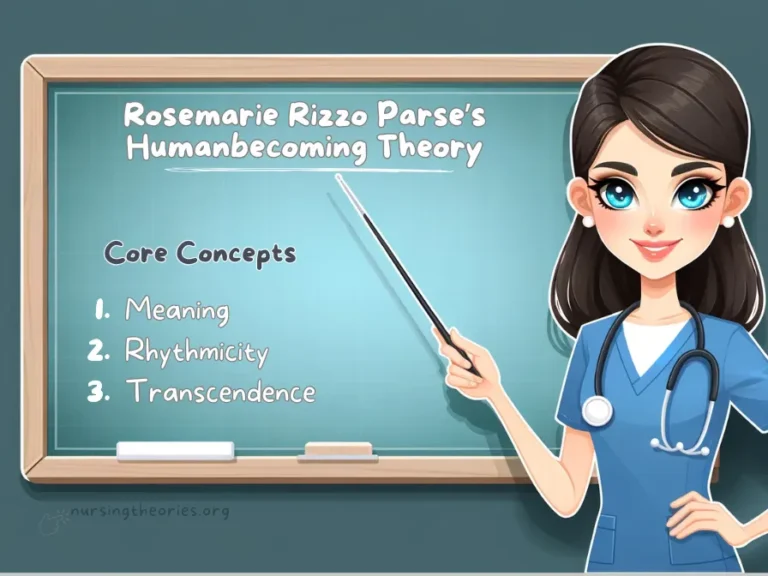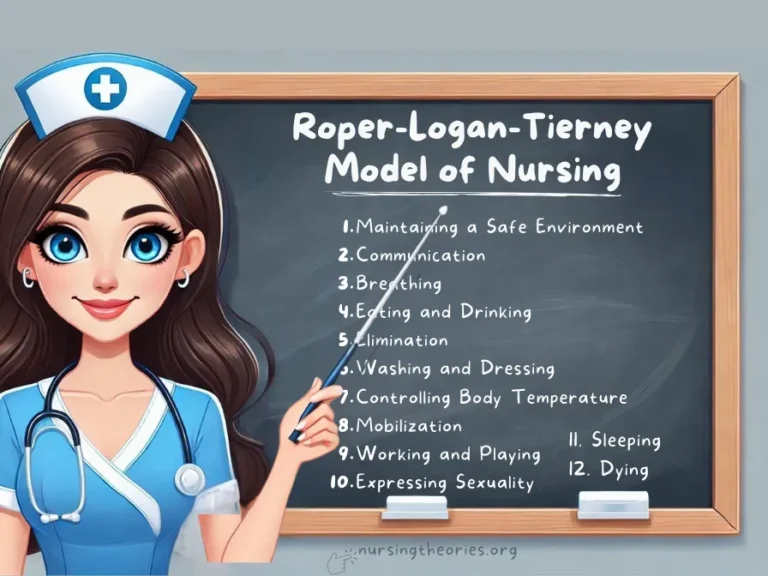Margaret Newman‘s Health as Expanding Consciousness Theory offers a transformative view of health, emphasizing the role of self-awareness and life patterns in healing.
Building directly on Martha Rogers’ Science of Unitary Human Beings, which views humans as unified energy fields in continuous interaction with their environment, Newman advanced these concepts to explore consciousness as a manifestation of evolving life patterns.
Rather than focusing solely on curing disease, the theory sees health as a dynamic process of personal growth and understanding.
Grounded in holistic nursing, Newman’s approach invites both patients and nurses to explore the interconnectedness between consciousness and well-being, making it highly relevant to modern nursing practice.
The purpose of this article is to explore the core concepts of Newman’s theory and demonstrate its practical application through real-life examples.

What You’ve Learned – Margaret Newman’s Health as Expanding Consciousness Theory
- Health is a process, not a state: Newman’s theory redefines health as the expansion of consciousness and self-awareness rather than the mere absence of illness.
- Life patterns influence well-being: Recognizing patterns within one’s life allows patients to address both physical and emotional challenges holistically.
- Nurse-patient relationships drive growth: The transformative relationship between nurses and patients promotes healing and personal growth.
- Healing requires reflection and meaning-making: Patients heal through understanding life patterns, gaining insight, and finding meaning in their experiences.
- Holistic care fosters long-term benefits: Addressing the patient’s mind, body, and spirit leads to better coping mechanisms and improved health outcomes.
Core Concepts of Margaret Newman’s Health as Expanding Consciousness Theory
Influenced by Martha Rogers, Newman reimagines health as a dynamic pattern of expanding consciousness rather than merely absence of illness.
The core concepts of Margaret Newman‘s Health as Expanding Consciousness Theory are:
I) Consciousness and Health Interconnected
Newman posits that health and consciousness are intertwined, with health representing an evolving state of awareness.
Core Principle: As patients become more conscious of their life patterns and inner experiences, they achieve higher levels of well-being.
- Example: A cancer survivor develops a newfound appreciation for life through reflection on their illness journey.
- Key Insight: Expanding consciousness transforms illness into an opportunity for personal growth and healing.
- Think of it as… Unlocking hidden doors—each discovery leads to a deeper understanding of oneself and life’s meaning.
II) Pattern Recognition as the Foundation of Care
The identification of recurring life patterns, both positive and negative, guides nursing interventions.
Core Principle: Nurses help patients recognize patterns in their health and behavior that may influence illness or healing.
- Example: A patient with frequent migraines realizes that stress and irregular sleep are key triggers.
- Key Insight: Understanding patterns allows patients to make changes that enhance their overall health.
- Think of it as… Connecting the dots of a picture—once the patterns emerge, the whole picture becomes clearer.
III) Transformative Nurse-Patient Relationship
The relationship between nurse and patient goes beyond clinical tasks, fostering trust, growth, and healing.
Core Principle: Nurses are facilitators of the patient’s journey, creating a space for exploration and reflection.
- Example: A nurse working with a grieving widow helps her find meaning and acceptance through supportive conversations.
- Key Insight: Compassionate partnerships enable patients to uncover new perspectives and emotional resilience.
- Think of it as… Walking alongside someone on a journey, offering support and guidance as they find their way.
The Nursing Process in Margaret Newman’s Theory
Step 1: Assessing Holistic Pattern Recognition in Newman’s Theory
The assessment phase involves collecting comprehensive data on the patient’s life patterns, emotional state, and physical condition.
- Example: A nurse assesses a patient with chronic fatigue by exploring both lifestyle habits and emotional stressors.
- Key Insight: Identifying patterns is crucial for developing interventions that promote holistic healing.
- Think of it as… Scanning a puzzle to identify key pieces that fit together, forming a complete picture.
Step 2: Diagnosing Underlying Life Patterns
Nurses analyze the assessment data to uncover underlying patterns influencing the patient’s health.
- Example: A patient with frequent infections is found to have an underlying pattern of neglecting self-care during stressful periods.
- Key Insight: Recognizing root causes helps address issues at their core, promoting long-lasting improvement.
- Think of it as… Detecting the cause of a recurring problem by examining the patterns leading up to it.
Step 3: Collaborative Planning to Expand Consciousness
Nurses and patients work together to develop personalized care plans aimed at expanding awareness and promoting healing.
- Example: A nurse and a patient with anxiety create a plan that includes journaling, mindfulness exercises, and regular counseling.
- Key Insight: Collaboration ensures that interventions are meaningful and aligned with the patient’s goals.
- Think of it as… Building a roadmap together—both nurse and patient know the destination and the path to get there.
Step 4: Implementing Transformative Interventions
The care plan is put into action through interventions that encourage reflection and self-discovery.
- Example: A nurse facilitates weekly reflective sessions with a patient recovering from trauma to explore emotional triggers.
- Key Insight: Interventions that focus on consciousness and meaning-making foster emotional healing.
- Think of it as… Planting seeds in fertile soil—over time, growth and healing naturally occur.
Step 5: Evaluating Progress in Consciousness and Health
Nurses assess whether the patient has achieved greater awareness and improved well-being through the interventions.
- Example: A patient who initially struggled with self-worth gains new coping skills and reports a greater sense of purpose after therapy.
- Key Insight: Evaluation ensures that interventions remain effective and can be adjusted as needed.
- Think of it as… Checking a compass during a hike to ensure you’re on the right path toward your destination.
Real-Life Case Studies Using Newman’s Theory
Case Study 1: Helping a Terminally Ill Patient Find Meaning
Scenario: A 68-year-old patient with advanced cancer is struggling emotionally, feeling hopeless about the end of life.
Application of the Theory: A nurse forms a trusting relationship, encouraging the patient to reflect on life accomplishments and relationships.
The nurse integrates journaling and reflective therapy to help the patient process emotions.
- Key Insight: The process of expanding consciousness allows the patient to find peace and purpose during the final stages of life.
- Think of it as… Lighting a path through a dark forest—guided reflection helps uncover moments of light and meaning.
Case Study 2: Managing Chronic Illness Through Awareness
Scenario: A 45-year-old patient with fibromyalgia experiences severe pain and frequent emotional breakdowns due to the condition.
Application of the Theory: The nurse identifies patterns linking the patient’s pain to emotional distress and lifestyle factors.
Through mindfulness training and relaxation exercises, the patient learns to manage stress and reduce symptom severity.
- Key Insight: Recognizing and addressing life patterns helps patients gain control over chronic conditions.
- Think of it as… Adjusting the sails of a boat—small changes in behavior can help navigate turbulent waters.
Case Study 3: Expanding Consciousness in Mental Health Recovery
Scenario: A 30-year-old patient recovering from anxiety and depression struggles to understand the root causes of their condition.
Application of the Theory: The nurse facilitates a combination of cognitive behavioral therapy and reflective journaling, helping the patient uncover thought patterns contributing to their distress.
Over time, the patient identifies self-defeating behaviors and develops positive coping mechanisms.
- Key Insight: Awareness of mental and emotional triggers allows for better self-regulation and long-term improvement.
- Think of it as… Clearing the fog—expanded consciousness reveals the path to emotional clarity.
Modern Implications of Margaret Newman’s Theory in Healthcare
I) Promoting Holistic Healing in Chronic Care
Integrating mind-body awareness into chronic care helps patients manage ongoing symptoms through self-reflection and expanded consciousness.
- Example: A patient with chronic back pain is guided through meditation and body scanning exercises to reduce stress-induced pain.
- Key Insight: Holistic approaches promote long-term improvement by addressing both physical and emotional dimensions of health.
- Think of it as… Tending to both the soil and the plant—addressing root issues leads to lasting growth.
II) Enhancing Mental Health Care
Newman’s theory offers valuable tools for addressing psychological challenges through self-awareness and meaning-making.
- Example: Patients undergoing therapy for post-traumatic stress are encouraged to explore life patterns through guided journaling.
- Key Insight: Expanded consciousness helps patients gain control over their thought patterns and develop healthier responses.
- Think of it as… Training the mind like a muscle—self-awareness strengthens resilience.
III) Supporting End-of-Life Care
Newman’s emphasis on meaning-making supports emotional peace and dignity in palliative and end-of-life care.
- Example: Nurses facilitate reflective discussions with terminally ill patients to help them find closure and emotional comfort.
- Key Insight: Meaning-making enhances quality of life, even in its final stages, by fostering acceptance and peace.
- Think of it as… Creating a peaceful sunset—finding beauty and comfort during life’s final moments.
Challenges and Limitations of Applying Newman’s Theory
I) Time-Intensive Nature of Expanding Consciousness
Nurses in fast-paced environments may struggle to allocate sufficient time for reflective discussions and holistic assessments.
- Example: In busy hospital settings, nurses may focus primarily on physical care, limiting opportunities for deeper emotional exploration.
- Key Solution: Implementing brief but meaningful reflective practices during regular assessments can make the process more feasible.
- Think of it as… Adding small drops to a bucket—consistent efforts lead to long-term impact.
II) Resistance to Self-Reflection Among Patients
Some patients may resist exploring emotional or life patterns, viewing it as unnecessary or uncomfortable.
- Example: A patient recovering from a traumatic event may avoid discussing their emotions due to fear of re-experiencing pain.
- Key Solution: Gradually building trust and introducing reflective practices in non-threatening ways can help patients open up.
- Think of it as… Slowly opening a door—patience and persistence help foster trust and acceptance.
III) Complexity of Holistic Interventions
Implementing holistic care requires collaboration among interdisciplinary teams, which can be challenging to coordinate.
- Example: A patient with multiple conditions may require input from nurses, counselors, physical therapists, and social workers.
- Key Solution: Clear communication and interdisciplinary meetings can ensure coordinated and effective care.
- Think of it as… Conducting an orchestra—each member plays a role in creating harmony in care delivery.
Margaret Newman’s Health as Expanding Consciousness Quiz
1) What is the core focus of Margaret Newman’s Health as Expanding Consciousness Theory?
a) Curing physical illness
b) Expanding self-awareness and recognizing life patterns
c) Reducing hospital readmission rates
d) Medication management
2) Which of the following best illustrates pattern recognition in Newman’s theory?
a) Monitoring a patient’s heart rate during treatment
b) Identifying the emotional and physical triggers of a patient’s migraines
c) Scheduling follow-up appointments
d) Administering pain relief without assessing emotional factors
3) How does Newman’s theory transform the nurse-patient relationship?
a) By limiting the relationship to medical interventions
b) By encouraging non-judgmental support and collaborative reflection
c) By eliminating emotional discussions
d) By focusing only on disease management
4) What is one major implication of applying Newman’s theory to chronic illness care?
a) Emphasizing physical treatments only
b) Encouraging patient reflection to address underlying emotional and behavioral triggers
c) Removing patient involvement in the care plan
d) Limiting care to acute conditions
5) What challenge might nurses face when applying Newman’s theory in practice?
a) Diagnosing physical conditions
b) Lack of interdisciplinary collaboration
c) Limited time to facilitate reflective practices
d) Administering medications
Margaret Newman’s Theory Quiz Answers with Rationale
- b) Expanding self-awareness and recognizing life patterns
Rationale: Newman’s theory focuses on expanding consciousness through identifying and understanding life patterns, enabling holistic healing. - b) Identifying the emotional and physical triggers of a patient’s migraines
Rationale: Pattern recognition is key to understanding how life experiences, emotions, and behaviors influence health. - b) By encouraging non-judgmental support and collaborative reflection
Rationale: The nurse-patient relationship in Newman’s theory involves creating a safe environment for self-exploration and healing. - b) Encouraging patient reflection to address underlying emotional and behavioral triggers
Rationale: Holistic care involves addressing not only physical symptoms but also the patterns contributing to chronic conditions. - c) Limited time to facilitate reflective practices
Rationale: Reflective and transformative interventions can be time-intensive, posing challenges in fast-paced settings.
Questions and Answers on Margaret Newman’s Health as Expanding Consciousness Theory
Q1: What is the primary goal of Newman’s theory?
A: The primary goal is to help patients achieve expanded consciousness and improve their health by recognizing and transforming life patterns.
Q2: How do nurses identify life patterns in patients?
A: Nurses gather data through holistic assessments, including physical, emotional, and social factors, to uncover recurring patterns affecting health.
Q3: What role does the nurse-patient relationship play in Newman’s theory?
A: The nurse-patient relationship is collaborative and supportive, promoting patient reflection, growth, and healing through expanded awareness.
Q4: How can Newman’s theory benefit patients with chronic illnesses?
A: By helping patients recognize and address underlying triggers and behaviors, the theory promotes better symptom management and overall well-being.
Q5: How can nurses overcome resistance to self-reflection among patients?
A: Gradually building trust and introducing reflective practices in a non-threatening manner can help patients feel more comfortable with self-exploration.
Conclusion of Margaret Newman’s Health as Expanding Consciousness Theory
Margaret Newman‘s Health as Expanding Consciousness Theory, building on Martha Rogers’ Science of Unitary Human Beings, redefines nursing practice by emphasizing the connection between consciousness, health, and well-being.
Through pattern recognition, holistic care, and transformative nurse-patient relationships, the theory extends Rogers’ concepts of unified energy fields and human-environment interaction to guide patients toward self-awareness and personal growth.
Its application in chronic care, mental health, and end-of-life settings highlights its versatility and relevance in modern healthcare.
Final Reflective Question: How can you integrate Margaret Newman’s theory into your practice to promote patient growth and long-term healing?




